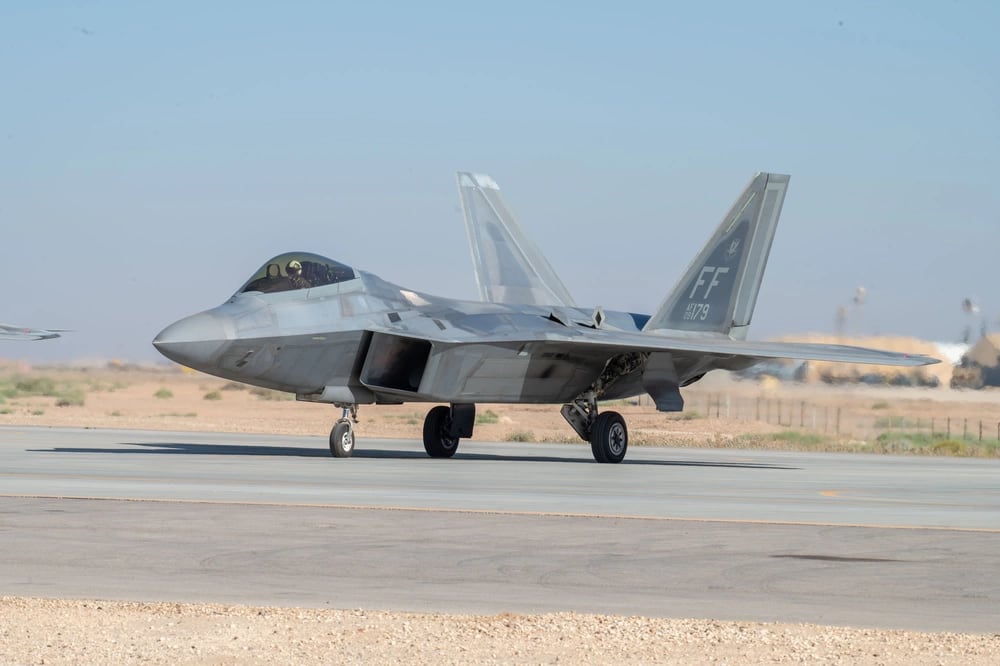U.S. F-22 Raptor fighter jets have deployed to the Middle East in a show of strength amid escalating tensions between U.S. and Russian forces that share the skies over Syria, U.S. Central Command said Wednesday.
Airmen from the 94th Fighter Squadron at Joint Base Langley-Eustis, Virginia, are the latest to arrive in a string of recent deployments to U.S. Central Command — and the first unit to specialize in air-to-air combat — after the Air Force’s top officer in the region said in April that Russian pilots had begun buzzing other American fighter jets over Syria in apparent invitations to dogfight.
“Russian forces’ unsafe and unprofessional behavior is not what we expect from a professional air force,” CENTCOM boss Army Gen. Erik Kurilla said in a release Wednesday. “Their regular violation of agreed-upon airspace deconfliction measures increases the risk of escalation or miscalculation.”
Speeding one of America’s most advanced fighter jets to the field aims to deter further bad behavior — and bolster U.S. firepower if needed. The military did not disclose from which base the F-22s will operate.
As the Pentagon’s premier fighter designed to down other aircraft, the Raptor relies on stealth technology, sophisticated maneuvers and up to eight short- and medium-range air-to-air missiles.
Their arrival signals that American military officials are increasingly alarmed by what they see as Russia’s attempts to intimidate American airmen and endanger U.S.-led coalition troops on the ground in Syria, flouting flight safety rules the two countries had agreed upon to avoid accidents and misunderstandings.
Russian aircraft violated longstanding deconfliction protocols 85 times from March 1-April 28, Air Forces Central told Air Force Times.
“They’re regularly flying directly overhead of our units … within about a mile, no more than a mile offset one side or the other, while we’ve got forces right there on the ground” at the U.S. coalition’s al-Tanf garrison in Syria, Grynkewich told NBC News. “It’s an uncomfortable situation.”
The Air Force did not immediately answer how often those incidents occurred in May and June.
In April, the Air Force released two videos that appear to show Russian Su-35 fighter jets veering close to American F-16 fighters in coalition airspace over Syria, filmed from the viewpoint of the F-16.
Grynkewich said close encounters have come within 500 feet of U.S. aircraft, despite miles-wide deconfliction zones and rules designed to keep jets thousands of feet away from each other. U.S. and Russian forces also share a hotline where they can discuss potential close calls.
Those measures are in place to prevent U.S. and Russian forces from seeing an incoming aircraft as an attack on their respective positions and retaliating in kind.
Grynkewich has suggested Russians may be growing more brash as a favor to their ally Iran, which opposes the U.S. military presence in the region.
In response, the Air Force this spring dispatched A-10C “Warthog” attack planes that are specially modified to carry around three times their typical bomb load.
“They’re really here as a message to both assure our partners … but also as … a true capability that can work against some of the threats that we face with respect to Iran,” Grynkewich told Defense One in April.
B-1B Lancer bombers, which carry conventional but not nuclear weapons, also arrived in CENTCOM for training earlier this month in a brief diversion from their current deployment to Europe.
The jets practiced shooting live precision-guided munitions and a Joint Air-to-Surface Standoff Missile, designed to hit mobile targets up to 230 miles away without triggering air defenses, the command said.
The Air Force said the mission was the first time its aircraft had fired multiple weapons at multiple simulated targets alongside coalition forces during a bomber rotation to the region.
“These bomber missions represent the U.S.’s commitment to our partners and showcase our ability to deliver overwhelming power at a moment’s notice,” Grynkewich said June 8.
While they support forces on opposite sides of Syria’s 12-year civil war, and are both fighting Islamic State militants, U.S. and Russian troops have not clashed directly.
Moscow backs the Assad regime in the conflict that has killed hundreds of thousands of civilians and displaced more than half of the country’s pre-war population.
About 900 U.S. personnel remain in Syria to advise and assist the patchwork of rebel forces that are fighting government troops. The Pentagon also continues to launch airstrikes and raids from elsewhere in the region in its decade-long mission to contain the Islamic State group inside Syria.
Rachel Cohen is the editor of Air Force Times. She joined the publication as its senior reporter in March 2021. Her work has appeared in the Washington Post, the Frederick News-Post (Md.), Air and Space Forces Magazine, Inside Defense, Inside Health Policy and elsewhere.





